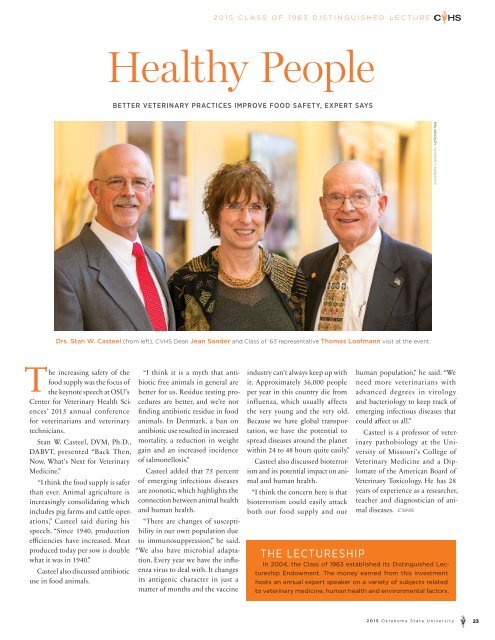Vet Cetera magazine 2015
Official magazine of the Center for Veterinary Health Sciences at Oklahoma State University
Official magazine of the Center for Veterinary Health Sciences at Oklahoma State University
Create successful ePaper yourself
Turn your PDF publications into a flip-book with our unique Google optimized e-Paper software.
<strong>2015</strong> CLASS OF 1963 DISTINGUISHED LECTURE<br />
Healthy People<br />
BETTER VETERINARY PRACTICES IMPROVE FOOD SAFETY, EXPERT SAYS<br />
PHIL SHOCKLEY / UNIVERSITY MARKETING<br />
Drs. Stan W. Casteel (from left), CVHS Dean Jean Sander and Class of ’63 representative Thomas Loafmann visit at the event.<br />
The increasing safety of the<br />
food supply was the focus of<br />
the keynote speech at OSU’s<br />
Center for <strong>Vet</strong>erinary Health Sciences’<br />
<strong>2015</strong> annual conference<br />
for veterinarians and veterinary<br />
technicians.<br />
Stan W. Casteel, DVM, Ph.D.,<br />
DABVT, presented “Back Then,<br />
Now, What’s Next for <strong>Vet</strong>erinary<br />
Medicine.”<br />
“I think the food supply is safer<br />
than ever. Animal agriculture is<br />
increasingly consolidating which<br />
includes pig farms and cattle operations,”<br />
Casteel said during his<br />
speech. “Since 1940, production<br />
efficiencies have increased. Meat<br />
produced today per sow is double<br />
what it was in 1940.”<br />
Casteel also discussed antibiotic<br />
use in food animals.<br />
“I think it is a myth that antibiotic<br />
free animals in general are<br />
better for us. Residue testing procedures<br />
are better, and we’re not<br />
finding antibiotic residue in food<br />
animals. In Denmark, a ban on<br />
antibiotic use resulted in increased<br />
mortality, a reduction in weight<br />
gain and an increased incidence<br />
of salmonellosis.”<br />
Casteel added that 75 percent<br />
of emerging infectious diseases<br />
are zoonotic, which highlights the<br />
connection between animal health<br />
and human health.<br />
“There are changes of susceptibility<br />
in our own population due<br />
to immunosuppression,” he said.<br />
“We also have microbial adaptation.<br />
Every year we have the influenza<br />
virus to deal with. It changes<br />
its antigenic character in just a<br />
matter of months and the vaccine<br />
industry can’t always keep up with<br />
it. Approximately 36,000 people<br />
per year in this country die from<br />
influenza, which usually affects<br />
the very young and the very old.<br />
Because we have global transportation,<br />
we have the potential to<br />
spread diseases around the planet<br />
within 24 to 48 hours quite easily.”<br />
Casteel also discussed bioterrorism<br />
and its potential impact on animal<br />
and human health.<br />
“I think the concern here is that<br />
bioterrorism could easily attack<br />
both our food supply and our<br />
human population,” he said. “We<br />
need more veterinarians with<br />
advanced degrees in virology<br />
and bacteriology to keep track of<br />
emerging infectious diseases that<br />
could affect us all.”<br />
Casteel is a professor of veterinary<br />
pathobiology at the University<br />
of Missouri’s College of<br />
<strong>Vet</strong>erinary Medicine and a Diplomate<br />
of the American Board of<br />
<strong>Vet</strong>erinary Toxicology. He has 28<br />
years of experience as a researcher,<br />
teacher and diagnostician of animal<br />
diseases.<br />
THE LECTURESHIP<br />
In 2004, the Class of 1963 established its Distinguished Lectureship<br />
Endowment. The money earned from this investment<br />
hosts an annual expert speaker on a variety of subjects related<br />
to veterinary medicine, human health and environmental factors.<br />
<strong>2015</strong> Oklahoma State University 23


